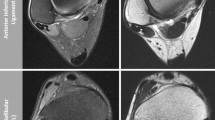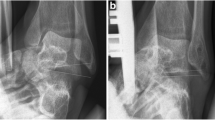Abstract
Objectives
The authors aim to present the common MRI appearances of surgically proven spring ligament tears as minimal radiological literature exists regarding injury to this increasingly important structure.
Materials and methods
Our retrospective review identified a treatment group comprising 13 cases of surgically proven spring ligament injury and a 96-patient comparison group. All patients underwent standard musculoskeletal MRI sequences of the foot and ankle. Images were reviewed by a registrar-grade orthopedic surgeon and a consultant musculoskeletal radiologist for abnormalities of the spring ligament complex.
Results
MRI findings in relation to surgically proven injury of the superior-medial portion of the spring ligament included proximal thickening >5 mm in 92 % and distal thinning <2 mm in 85 % of proven injures to the spring ligament complex. Common abnormalities of the medio-plantar portion comprised ligament thickening >7 mm in 31 % and intra-substance signal heterogenicity demonstrated in 38 % of cases.
Conclusions
The complex orientation of the medio-plantar ligament makes its evaluation unreliable due to the difficulty obtaining diagnostic quality imaging and our inability to correlate MRI findings in this portion of the ligament with surgically proven injury. However, MRI abnormalities of the superior-medial ligament are consistent, reproducible, and correlate with surgical pathology. As our incomplete understanding of the flexible flatfoot deformity evolves, our ability to recognize injury to the spring ligament may encourage novel surgical treatments looking to incorporate its repair or reconstruction into deformity correction.





Similar content being viewed by others
References
Gazdag AR, Cracchiolo III A. Rupture of the posterior tibial tendon: evaluation of injury of the spring ligament and clinical assessment of tendon transfer and ligament repair. J Bone Joint Surg Am. 1997;79:675–81.
Balen PF, Helms CA. Association of posterior tibial tendon injury with spring ligament injury, sinus tarsi abnormality, and plantar fasciitis on MR imaging. AJR Am J Roentgenol. 2001;176:1137–43.
Myerson MS. Adult acquired flatfoot deformity: treatment of dysfunction of the posterior tibial tendon. Instr Course Lect. 1997;46:393–405.
Yao L, Gentili A, Cracchiolo A. MRI imaging findings in spring ligament insufficiency. Skeletal Radiol. 1999;28:245–50.
Borton DC, Saxby TS. Tear of the plantar calcaneonavicular (spring) ligament causing flatfoot. A case report. J Bone Joint Surg Br. 1997;79:641–3.
Davis W, Sobel M, DiCarlo E, et al. Gross, histological, and microvascular anatomy and biomechanical testing of the spring ligament complex. Foot Ankle Int. 1996;17:95–102.
Cheung Y, Rosenberg ZS. MR imaging of ligamentous abnormalities of the ankle and foot. Magn Reson Imaging Clin N Am. 2001;9:507–31.
Johnson KA, Strom DE. Tibialis posterior tendon dysfunction. Clin Orthop Relat Res. 1989;239:196–206.
Deland JT, de Asla RJ, Sung IH, Emberg LA, Potter HG. Posterior tibial tendon insufficiency: which ligaments are involved. Foot Ankle Int. 2005;26:427–35.
Younger AS, Sawatzky B, Dryden P. Radiographic assessment of adult flatfoot. Foot Ankle Int. 2005;26:820–5.
Taniguchi A, Tanaka Y, Takakura Y, Kadono K, Maeda M, Yamamoto H. Anatomy of the spring ligament. J Bone Joint Surg Am. 2003;85:2174–8.
Mengiardi B, Zanetti M, Schöttle PB, Vienne P, Bode B, Hodler J, et al. Spring ligament complex: MR imaging-anatomic correlation and findings in asymptomatic subjects. Radiology. 2005;237:242–9.
Toye LR, Helms CA, Hoffman BD, Easley M, Nunley JA. MRI of spring ligament tears. AJR Am J Roentgenol. 2005;184:1475–80.
Feighan J, Towers J, Conti S. The use of magnetic resonance imaging in posterior tibial tendon dysfunction. Clin Orthop Relat Res. 1999;365:23–38.
Schweitzer ME, Caccese R, Karasick D, Wapner KL, Mitchell DG. Posterior tibial tendon tears: utility of secondary signs for MR imaging diagnosis. Radiology. 1993;188:655–9.
Koomia CL, Anderson K, Craig JV, Teeter DM, van Holsbeeck M. Evidence of subclinical medial collateral ligament injury and posteromedial impingement in professional baseball players. Am J Sports Med. 2004;32:1602–6.
Shuen V, Prem H. Acquired unilateral pesplanus in a child caused by a ruptured plantar calcaneonavicular (spring) ligament. J Pediatr Orthop B. 2009;18:129–30.
Tryfonidis M, Jackson W, Mansour R, Cooke PH, Teh J, Ostlere S, et al. Acquired adult flat foot due to isolated plantar calcaneonavicular (spring) ligament insufficiency with a normal tibialis posterior tendon. Foot Ankle Surg. 2008;14:89–95.
Shibuya N, Ramanujam C, Glenn M, Garcia MD. Association of tibialis posterior tendon pathology with other radiographic findings in the foot: a case–control study. J Foot Ankle Surg. 2008;47:546–53.
Kier R, Dietz MJ, McCarthy SM, Rudicel SA. MR imaging of the normal ligaments and tendons of the ankle. J Comput Assist Tomogr. 1991;15:477–82.
Jennings MM, Christensen JC. The effects of sectioning the spring ligament on rear foot stability and posterior tibial tendon efficiency. J Foot Ankle Surg. 2008;47:219–24.
Yeap JS, Birch R, Singh D. Long-term results of tibialis posterior tendon transfer for drop-foot. Int Orthop. 2001;25:114–8.
Iaquinto JM, Wayne JS. Computational model of the lower leg and foot/ankle complex: application to arch stability. J Biomech Eng. 2010;132:1–6.
Tao K, Ji WT, Wang DM, Wang CT, Wang X. Relative contributions of plantar fascia and ligaments on the arch static stability: a finite element study. Biomed Tech. 2010;55:265–71.
Deland. Adult acquired flatfoot deformity. J Am Acad Orthop Surg. 2008;16:399–406.
Conflict of interest
None.
Author information
Authors and Affiliations
Corresponding author
Rights and permissions
About this article
Cite this article
Williams, G., Widnall, J., Evans, P. et al. MRI features most often associated with surgically proven tears of the spring ligament complex. Skeletal Radiol 42, 969–973 (2013). https://doi.org/10.1007/s00256-013-1618-3
Received:
Revised:
Accepted:
Published:
Issue Date:
DOI: https://doi.org/10.1007/s00256-013-1618-3




